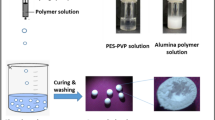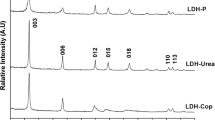Abstract
Casting method was used to synthesize a novel sodium alginate nanohybrid functionalized with aminated ZnO/SiO2 Schiff base for adsorption of nickel (Ni2+) and copper (Cu2+) divalent cations in single and binary water systems. The cast Schiff base nanohybrids were investigated using FESEM, XRD, BET, FTIR, TGA, and XPS analyses. The influence of unfunctionalized binary ZnO/SiO2 nano oxides and aminated Schiff base ligands formed by the reaction between salicylaldehyde and O-phenylenediamine on the adsorption of Ni2+ and Cu2+ cations was evaluated. The results confirmed that the aminated Schiff base ligands led to a higher adsorption ability of the cast nanohybrids containing interaction of divalent cations with nitrogen and oxygen atoms, as well as carboxyl and hydroxyl groups. The adsorption kinetics and isotherm for both cations followed a double-exponential model and the Redlich-Peterson model, respectively. The maximum monolayer capacity was found to be 249.8 mg/g for Cu2+ cation and 96.4 mg/g for Ni2+ cation. Thermodynamic analysis revealed an endothermic and spontaneous adsorption process with an increase in entropy. Furthermore, the synthesized Schiff base adsorbent could be easily reused over five times. The simultaneous adsorption in binary system exhibited a higher adsorption selectivity of the cast Schiff base nanohybrid for Cu2+ cation compared to Ni2+ cation. It was found that the removal percentages of Cu2+ and Ni2+ from industrial electroplating wastewater were 91.3 and 64.5%, respectively. Lastly, cost analysis of the synthesized nanohybrid was investigated.










Similar content being viewed by others
Data availability
All data related to this study are included in the manuscript.
References
Abbasizadeh S, Keshtkar AR, Mousavian MA (2014) Sorption of heavy metal ions from aqueous solution by a novel cast PVA/TiO2 nanohybrid adsorbent functionalized with amine groups. J Ind Eng Chem 20:1656–1664. https://doi.org/10.1016/j.jiec.2013.08.013
Ablouh E, Hanani Z, Eladlani N, Rhazi M, Taourirte M (2019) Chitosan microspheres/sodium alginate hybrid beads: an efficient green adsorbent for heavy metals removal from aqueous solutions. Sustainable Environ Res 29:1–11. https://doi.org/10.1186/s42834-019-0004-9
Adeli M, Yamini Y, Faraji M (2017) Removal of copper, nickel and zinc by sodium dodecyl sulphate coated magnetite nanoparticles from water and wastewater samples. Arabian J Chem 10:S514–S521. https://doi.org/10.1016/j.arabjc.2012.10.012
Alhokbany N, Ahamad T, Naushad M, Alshehri SM (2019) Feasibility of toxic metal removal from aqueous medium using Schiff-base based highly porous nanocomposite: Adsorption characteristics and post characterization. J Mol Liq 294:111598. https://doi.org/10.1016/j.molliq.2019.111598
Arshad M, Qayyum A, Abbas G, Haider R, Iqbal M, Nazir A (2018) Influence of different solvents on portrayal and photocatalytic activity of tin-doped zinc oxide nanoparticles. J Mol Liq 260:272–278. https://doi.org/10.1016/j.molliq.2018.03.074
Betiha MA, Moustafa YM, El-Shahat MF, Rafik E (2020) Polyvinylpyrrolidone-Aminopropyl-SBA-15 schiff Base hybrid for efficient removal of divalent heavy metal cations from wastewater. J Hazard Mater 397:122675. https://doi.org/10.1016/j.jhazmat.2020.122675
Bilgic A (2022) Synthesis and Characterization of the Schiff Base-on Functionalized Novel Sporopollenin Microcapsule and Its Use for Effective Adsorption of Cu2+. J Inst Sci Tech 12:279–286. https://doi.org/10.21597/jist.987744
Bozorgi M, Abbasizadeh S, Samani F, Mousavi SE (2018) Performance of synthesized cast and electrospun PVA/chitosan/ZnO-NH2 nano-adsorbents in single and simultaneous adsorption of cadmium and nickel ions from wastewater. Environ Sci Pollut Res 25:17457–17472. https://doi.org/10.1007/s11356-018-1936-z
Chandra D, Molla MTH, Bashar MA, Islam MS, Ahsan MS (2023) Chitosan-based nano-sorbents: synthesis, surface modification, characterisation and application in Cd2+, Co2+, Cu2+ and Pb2+ ions removal from wastewater. Sci Rep 13:6050. https://doi.org/10.1038/s41598-023-32847-3
Chiron N, Guilet R, Deydier E (2003) Adsorption of Cu2+ and Pb2+ onto a grafted silica: isotherms and kinetic models. Water Res 37:3079–3086. https://doi.org/10.1016/S0043-1354(03)00156-8
Dong Y, Sang D, He C, Sheng X, Lei L (2019) Mxene/alginate composites for lead and copper ion removal from aqueous solutions. RSC Adv 9:29015–29022. https://doi.org/10.1039/C9RA05251H
Eskandari M, Fakhroueian Z, Dastjerdi M, Bahri Z, Kaman M (2021) Improving copper recovery from oxide sources in flotation process using sodium dodecyl sulfate modified ZnO nanoparticles as new collector. Chem Papers 75:4371–4379. https://doi.org/10.1007/s11696-021-01677-w
Faghihian H, Adibmehr Z (2018) Comparative performance of novel magnetic ion-imprinted adsorbents employed for Cd2+, Cu2+ and Ni2+ removal from aqueous solutions. Environ Sci Pollut Res 25:15068–15079. https://doi.org/10.1007/s11356-018-1732-9
Gugushe AS, Mpupa A, Munonde TS, Nyaba L, Nomngongo PN (2021) Adsorptive removal of Cd, Cu, Ni and Mn from environmental samples using Fe3O4-ZrO2@ APS nanocomposite: kinetic and equilibrium isotherm studies. Molecules 26:3209. https://doi.org/10.3390/molecules26113209
Guo Y, Xiao Y, Wu H, Xu J, Chen Q (2021) Efficient removal of Pb2+ ions from aqueous solution by using a novel functionalized bio-material with two tridentate coordinated units. J Chem Tech Biotechnol 96:1709–1719. https://doi.org/10.1002/jctb.6696
Hallaji H, Keshtkar AR, Moosavian MA (2015) A novel electrospun PVA/ZnO nanofiber adsorbent for U6+, Cu2+ and Ni2+ removal from aqueous solution. J Taiwan Inst Chem Eng 46:109–118. https://doi.org/10.1016/j.jtice.2014.09.007
Hassan M, Naidu R, Du J, Qi F, Ahsan MA, Liu Y (2022) Magnetic responsive mesoporous alginate/β-cyclodextrin polymer beads enhance selectivity and adsorption of heavy metal ions. Int J Biol Macromol 207:826–840. https://doi.org/10.1016/j.ijbiomac.2022.03.159
Helmiyati H, Suci R (2019) Nanocomposite of cellulose-ZnO/SiO2 as catalyst biodiesel methyl ester from virgin coconut oil. AIP Conf Proc 2168:020063. https://doi.org/10.1063/1.5132490
Hua M, Zhang S, Pan B, Zhang W, Lv L, Zhang Q (2012) Heavy metal removal from water/wastewater by nanosized metal oxides: a review. J Hazard Mater 211:317–331. https://doi.org/10.1016/j.jhazmat.2011.10.016
Huang XJ, Zeng XF, Wang JX, Zhang LL, Chen JF (2019) Synthesis of monodispersed ZnO@ SiO2 nanoparticles for anti-UV aging application in highly transparent polymer-based nanocomposites. J Mater Sci 54:8581–8590. https://doi.org/10.1007/s10853-019-03393-z
Ighalo JO, Omoarukhe FO, Ojukwu VE, Iwuozor KO, Igwegbe CA (2022) Cost of adsorbent preparation and usage in wastewater treatment: a review. Cleaner Chem Eng 3:100042. https://doi.org/10.1016/j.clce.2022.100042
İnal M, Erduran N (2015) Removal of various anionic dyes using sodium alginate/poly (N-vinyl-2-pyrrolidone) blend hydrogel beads. Polym Bull 72:1735–1752. https://doi.org/10.1007/s00289-015-1367-7
Isawi H (2020) Using zeolite/polyvinyl alcohol/sodium alginate nanocomposite beads for removal of some heavy metals from wastewater. Arabian J Chem 13:5691–5716. https://doi.org/10.1016/j.arabjc.2020.04.009
Jafarnejad M, Asli MD, Taromi FA, Manoochehri M (2020) Synthesis of multi-functionalized Fe3O4-NH2-SH nanofiber based on chitosan for single and simultaneous adsorption of Pb2+ and Ni2+ from aqueous system. Int J Biol Macromol 148:201–217. https://doi.org/10.1016/j.ijbiomac.2020.01.017
Jafarnejad M, Asli MD, Taromi FA, Manoochehri M (2021) Preparation of cast chitosan/polyether sulfone/Fe3O4 modified with mercapto and amine groups as a novel nanohybrid adsorbent for heavy metal removal from single and binary aqueous systems. Res Chem Intermed 47:5321–5351. https://doi.org/10.1007/s11164-021-04582-9
Kumar KS, Divya A, Reddy PS (2011) Synthesis and characterization of Cr doped CdS nanoparticles stabilized with polyvinylpyrrolidone. App Surf Sci 257:9515–9518. https://doi.org/10.1016/j.apsusc.2011.06.048
Li F, Huang X, Jiang Y, Liu L, Li Z (2009) Synthesis and characterization of ZnO/SiO2 core/shell nanocomposites and hollow SiO2 nanostructures. Mater Res Bull 44:437–441. https://doi.org/10.1016/j.materresbull.2008.04.024
Liu H, Wang Q, Zhang F (2020) Preparation of Fe3O4@ SiO2@ P(AANa-co-AM) composites and their adsorption for Pb2+. ACS Omega 5:8816–8824. https://doi.org/10.1021/acsomega.0c00403
Maftouh A, El Fatni O, El Hajjaji S, Jawish MW, Sillanpää M (2023) Comparative review of different adsorption techniques used in heavy metals removal in water. Biointerface Res Appl Chem 13:397. https://doi.org/10.33263/BRIAC134.397
Oghabneshin Y, Seddighi S, Zabetian M, Mohammadebrahim A (2018) Experimental and numerical analysis of the in-cylinder swirl flow dependence on the pressure. Heat Mass Transfer 54:3547–3558. https://doi.org/10.1007/s00231-018-2384-5
Onutai S, Kobayashi T, Thavorniti P, Jiemsirilers S (2018) Removal of Pb2+, Cu2+, Ni2+, Cd2+ from wastewater using fly ash based geopolymer as an adsorbent. Key Eng Mater 773:373–378. https://doi.org/10.4028/www.scientific.net/KEM.773.373
Qasem NA, Mohammed RH, Lawal DU (2021) Removal of heavy metal ions from wastewater: A comprehensive and critical review. Npj Clean Water 4:36. https://doi.org/10.1038/s41545-021-00127-0
Rao KM, Rao KK, Sudhakar P, Rao KC, Subha M (2013) Synthesis and Characterization of biodegradable Poly (Vinyl caprolactam) grafted on to sodium alginate and its microgels for controlled release studies of an anticancer drug. J Appl Pharmaceutical Sci 3:61–69. https://doi.org/10.7324/JAPS.2013.3609
Salehi-Babarsad F, Derikvand E, Razaz M, Yousefi R, Shirmardi A (2020) Heavy metal removal by using ZnO/organic and ZnO/inorganic nanocomposite heterostructures. Int J Environ Analyt Chem 100:702–719. https://doi.org/10.1080/03067319.2019.1639685
Sarma GK, Sen Gupta S, Bhattacharyya KG (2019) Nanomaterials as versatile adsorbents for heavy metal ions in water: a review. Environ Sci Pollut Res 26:6245–6278. https://doi.org/10.1007/s11356-018-04093-y
Shafiee M, Abedi MA, Abbasizadeh S, Sheshdeh RK, Mousavi SE, Shohani S (2020) Effect of zeolite hydroxyl active site distribution on adsorption of Pb2+ and Ni2+ pollutants from water system by polymeric nanofibers. Sep Sci Tech 55:1994–2011. https://doi.org/10.1080/01496395.2019.1624572
Shi H, Xie Z, Zhang Y, Yuan A, Xu J (2019) A SiOC anode material derived from PVA-modified polysiloxane with improved Li-storage cycling stability. Ionics 25:3051–3058. https://doi.org/10.1007/s11581-019-02872-2
Shoja F, Amani MA (2020) Multi-modification of Na-Y zeolite with ZnO nanoparticles, amine, and mercapto functional groups for single and simultaneous heavy metal adsorption from water system. Res Chem Intermed 46:3569–3591. https://doi.org/10.1007/s11164-020-04162-3
Tabatabaeefar A, Keshtkar AR, Talebi M, Abolghasemi H (2020) Polyvinyl alcohol/alginate/zeolite nanohybrid for removal of metals. Chem Eng Tech 43:343–354. https://doi.org/10.1002/ceat.201900231
Talebi M, Abbasizadeh S, Keshtkar AR (2017) Evaluation of single and simultaneous thorium and uranium sorption from water systems by an electrospun PVA/SA/PEO/HZSM5 nanofiber. Process Saf Environ Prot 109:340–356. https://doi.org/10.1016/j.psep.2017.04.013
Tehrani MM, Abbasizadeh S, Alamdari A, Mousavi SE (2017) Prediction of simultaneous sorption of copper, cobalt and zinc contaminants from water systems by a novel multi-functionalized zirconia nanofiber. Desalin Water Treat 62:403–417. https://doi.org/10.5004/dwt.2017.20135
Trikkaliotis DG, Ainali NM, Tolkou AK, Mitropoulos AC, Lambropoulou DA, Bikiaris DN, Kyzas GZ (2022) Removal of heavy metal ions from wastewaters by using chitosan/poly (vinyl alcohol) adsorbents: A review. Macromol 2:403–425. https://doi.org/10.3390/macromol2030026
Vafakish B, Wilson LD (2020) Cu2+ Ion adsorption by Aniline grafted Chitosan and its responsive fluorescence properties. Molecules 25:1052. https://doi.org/10.3390/molecules25051052
Vasudevan P, Thomas S, Biju P, Sudarsanakumar C, Unnikrishnan N (2012) Synthesis and structural characterization of sol–gel derived titania/poly (vinyl pyrrolidone) nanocomposites. J Sol-Gel Sci Tech 62:41–46. https://doi.org/10.1007/s10971-012-2680-3
Wang M, You X-y (2023) Efficient adsorption of antibiotics and heavy metals from aqueous solution by structural designed PSSMA-functionalized-chitosan magnetic composite. Chem Eng J 454:140417. https://doi.org/10.1016/j.cej.2022.140417
Wu HY, Jian WJ, Dang HF, Zhao XF, Zhang LZ, Li JH (2017) Hierarchical Ag-ZnO Microspheres with Enhanced Photocatalytic Degradation Activities. Pol J Environ Stud 26:871–880. https://doi.org/10.15244/pjoes/65363
Yadav S, Asthana A, Singh AK, Chakraborty R, Vidya SS, Susan MABH, Carabineiro SA (2021) Adsorption of cationic dyes, drugs and metal from aqueous solutions using a polymer composite of magnetic/β-cyclodextrin/activated charcoal/Na alginate: Isotherm, kinetics and regeneration studies. J Hazard Mater 409:124840. https://doi.org/10.1016/j.jhazmat.2020.124840
Yari S, Abbasizadeh S, Mousavi SE, Moghaddam MS, Moghaddam AZ (2015) Adsorption of Pb2+ and Cu2+ ions from aqueous solution by an electrospun CeO2 nanofiber adsorbent functionalized with mercapto groups. Process Saf Environ Prot 94:159–171. https://doi.org/10.1016/j.psep.2015.01.011
Funding
The authors declare that no funds, grants, or other support were received during the preparation of this manuscript.
Author information
Authors and Affiliations
Contributions
Conceptualization: Hadis Moridi and Azar Bagheri Gh; Methodology: Hadis Moridi; Data curation: Hadis Moridi; Formal analysis and investigation: Hadis Moridi and Azar Bagheri Gh; Writing—original draft preparation: Hadis Moridi; Writing—review and editing: Azar Bagheri Gh; Data collection: Hadis Moridi; Supervision: Azar Bagheri Gh. All authors read and approved the final manuscript.
Corresponding author
Ethics declarations
Ethical approval
The submitted manuscript is original and have not been published elsewhere in any form or language. Compliance with ethical standards.
Consent to participate
All authors whose names appear on the submission made substantial contributions to the conception or design of the work.
Consent for publication
All authors agree with the manuscript content and gave explicit permission to submit this research.
Competing interests
The authors have no relevant financial or non-financial interests to disclose.
Additional information
Responsible Editor: Tito Roberto Cadaval Jr
Publisher's Note
Springer Nature remains neutral with regard to jurisdictional claims in published maps and institutional affiliations.
Rights and permissions
Springer Nature or its licensor (e.g. a society or other partner) holds exclusive rights to this article under a publishing agreement with the author(s) or other rightsholder(s); author self-archiving of the accepted manuscript version of this article is solely governed by the terms of such publishing agreement and applicable law.
About this article
Cite this article
Moridi, H., Gh, A.B. Functionalization of a cast NaAl/binary ZnO/SiO2 nanohybrid with amine and Schiff base ligands as an adsorbent of divalent cations in water system. Environ Sci Pollut Res (2024). https://doi.org/10.1007/s11356-024-32148-w
Received:
Accepted:
Published:
DOI: https://doi.org/10.1007/s11356-024-32148-w




